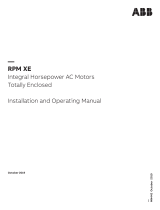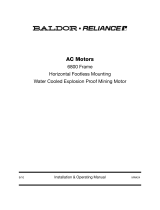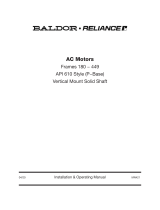Page is loading ...

1
WARNING: To ensure the drive is not unexpectedly
started, turn off and lock-out or tag power source
before proceeding. Failure to observe these
precautions could result in bodily injury.
WARNING: All products over 25 kg (55 lbs) are noted
on the shipping package. Proper lifting practices are
required for those products.
INSTALLATION INSTRUCTIONS
1. Clean shaft and bore of bearing. Lubricate with
light coat of oil or anti-seize compound.
2. Slip bearing in position noting Step 3.
3. Expansion Bearings: Bolt outer housing to
support. Expansion-type outer housing should
be located so inner unit can move freely in either
direction. Outer housing shims provide a proper t
and must not be removed.
Non-Expansion Bearings: Loosen cap bolts in
outer housing a little so inner unit is free to align
in outer housing. The hold-down bolts should
be loose in the bolt holes. If the bolts are tight in
the bolt holes, the unit should be moved slightly
on the shaft to provide looseness. This will help
prevent preloading or inducing an initial thrust
on bearings. Tighten nut on hold down bolts.
Retighten cap bolts. Outer housing shims provide
a proper t and must not be removed.
4. Tighten setscrews to the torque values shown in
Table 1.
5. The effort required to turn the shaft should be
the same before and after bolting bearings to the
support.
WARNING: Because of the possible danger to person(s) or
property from accidents which may result from the improper
use of products, it is important that correct procedures be
followed: Products must be used in accordance with the
engineering information specified in the catalog. Proper
installation, maintenance and operation procedures must
be observed. The instructions in the instruction manuals
must be followed. Inspections should be made as necessary
to assure safe operation under prevailing conditions. Proper
guards and other suitable safety devices or procedures as
may be desirable or as may be specified in safety codes
should be provided, and are neither provided by Baldor
Electric Company nor are the responsibility of Baldor
Electric Company. This unit and its associated equipment
must be installed, adjusted and maintained by qualified
personnel who are familiar with the construction and
operation of all equipment in the system and the potential
hazards involved. When risk to persons or property may be
involved, a holding device must be an integral part of the
driven equipment beyond the speed reducer output shaft.
DOUBLE INTERLOCK Flange,
B-1, S-1 and D Unit Bearings 1-3/8” to 5”
These instructions must be read thoroughly before installation or operation. This instruction manual was accurate at time of printing.
Please see www.baldor.com for updated instruction manuals.
Replacing a Unit in a Pillow Block
1. Match cap and base of each outer housing before
removing cap. When reassembling pillow blocks
make sure match marks on caps and bases match.
2. Fit each unit to its outer housing before putting
on shaft.
3. Add or remove shims between cap and base
as required to obtain “snug” t of unit in outer
housing with cap bolts drawn down securely.
4. Check t by prying against lubrication stud in unit
through the lubrication hole in housing cap with
a screwdriver or small pinch bar depending upon
size of the pillow blocks.
5. The “snug” t becomes a matter of judgment. A
“loose” or “sloppy” t may allow a unit to move
in its outer housing thus wearing the mating
surfaces. Too “tight” a t will not allow the unit
to move and compensate for misalignment and
for shaft deection caused by belt pull and dead
weight.
6. Install bearings per steps 1 to 4 above.
Table 1 - Setscrew Torque
Bore Size Setscrew Size In. - lbs.
1-3/16 - 1-11/16 5/16 165
1-3/4 - 2-1/2 3/8 290
2-11/ 16 - 3-1/2 1/2 620
3-15/16 - 5 5/8 1325
Table 2 - Bolts Tightening Torque
Bolt Size
Torque
ft. -lbs.
3/8-16 20
1/2-13 50
5/8-11 100
3/4-10 175
7/8-9 170
1-8 250
1-1/ 8-7 350
LUBRICATION GUIDELINES
This bearing is factory lubricated with a lithium or
lithium complex base grease which is suitable for most
applications. However, extra protection is necessary if
the bearing is subjected to excessive moisture, dust,
corrosive vapor or other harsh environments. In these
cases, the bearing should contain as much grease
as speed will permit (a full bearing with consequent
slight leakage through the seal is the best protection
against contaminant entry).

P.O. Box 2400, Fort Smith, AR 72902-2400 U.S.A., Ph: (1) 479.646.4711, Fax (1) 479.648.5792, International Fax (1) 479.648.5895
Dodge Product Support
6040 Ponders Court, Greenville, SC 29615-4617 U.S.A., Ph: (1) 864.297.4800, Fax: (1) 864.281.2433
www.baldor.com
For relubrication, select a grease that is compatible
with a lithium or lithium complex grease. The following
table is a general guide for normal operating conditions.
However, some situations may require a change in
lubricating periods as dictated by experience.
Lubrication Guide
NOTE: Read preceding paragraphs before establishing
lubrication schedule.
Table 3 - Lubrication Guide
Hours
Run Per
Day
Suggested Lubrication Period in Weeks
1 to
250
RPM
251 to
500
RPM
501
to 750
RPM
751 to
1000
RPM
1001
to
1500
RPM
1501
to
2000
RPM
2001
to
2500
RPM
2501
to
3000
RPM
8 12 12 10 7 5 4 3 2
16 12 7 5 4 2 2 2 1
24 10 5 3 2 1 1 1 1
Lubrication recommendations are intended for
standard products applied in normal operating
conditions. For modied products, high temperature
environments and other anomalous applications,
contact product engineering at 864-284-5700.
Normal Operation—This bearing has been greased
at the factory and is ready to run. Table 3 is a general
guide for relubrication. However, certain conditions
may require a change of lubricating periods as
dictated by experience. See sections for “High Speed
Operation” and “Operating in Presence of Dust,
Water, or Corrosive Vapors”.
High Speed Operation — High speed operation is
70% of maximum catalog speed and above. In the
higher speed ranges too much grease will cause
overheating. The amount of grease that the bearing
will take for a particular high speed application can
only be determined by experience—see “Operating
Temperature”. If excess grease in the bearing causes
overheating, it will be necessary to remove grease
tting (also drain plug when furnished) to permit
excess to escape. The bearing has been greased at
the factory and is ready to run. When establishing
a relubrication schedule, note that a small amount
of grease at frequent intervals is preferable to large
amount at infrequent intervals.
Operation in Presence of Dust, Water or Corrosive
Vapors—Under these conditions the bearing should
contain as much grease as speed will permit since
a full bearing with consequent slight leakage is the
best protection against entrance of foreign material.
In the higher speed ranges too much grease will
cause overheating— see “High Speed Operation”. In
the lower speed ranges it is advisable to add extra
grease to a new bearing before putting into operation.
Bearings should be greased as often as necessary
(daily if required) to maintain a slight leakage at the
seals.
Operating Temperature— Abnormal bearing
temperature may indicate faulty lubrication. Normal
temperature may range from a few degrees up to 100°F
above ambient, depending on bearing size, speed,
loading and environmental conditions. Unusually high
temperature, in this range, accompanied by excessive
leakage of grease indicates too much grease. In
the circumstance that there is excess grease in the
bearing, remove the grease tting to allow the excess
grease to purge. When purging ceases, wipe excess
grease with a clean rag and screw tting back into the
bearing. High temperature with no grease showing
at the seals, particularly if the bearing seems noisy,
usually indicates too little grease. Normal temperature
and a slight showing of grease at the seals indicate
proper lubrication.
Special Operating Conditions —Refer acid,
chemical, extreme or other special operating
conditions to Baldor Electric Company, BaldorDodge
Product Support, Greenville, South Carolina.
Kind of Grease —Many ordinary cup greases will
disintegrate at speeds far below those at which
BaldorDodge bearings will operate successfully
if proper grease is used. BaldorDodge bearings
have been lubricated at the factory with an NLGI
#2 lithium complex base grease. Relubricate with
lithium complex-base grease or a grease which is
compatible with the original lubricant and suitable for
roller bearing service. In unusual or doubtful cases the
recommendation of a reputable grease manufacturer
should be secured.
Storage or Special Shutdown — If exposed to
wet or dusty conditions or to corrosive vapors, extra
protection is necessary Add grease until it shows
at the seals, rotate the bearing to distribute grease;
cover the bearing. After storage or idle period, add a
little fresh grease before running.
Successful operation is dependent upon adequate
lubrication. Precaution should be taken during
handling and recycling grease, oil or water glycol
mixtures.
All Rights Reserved. Printed in USA.
04/16 Litho 15,000
© Baldor Electric Company
MN3035 (Replaces 499795
& 499796)
*3035-0416*
/








